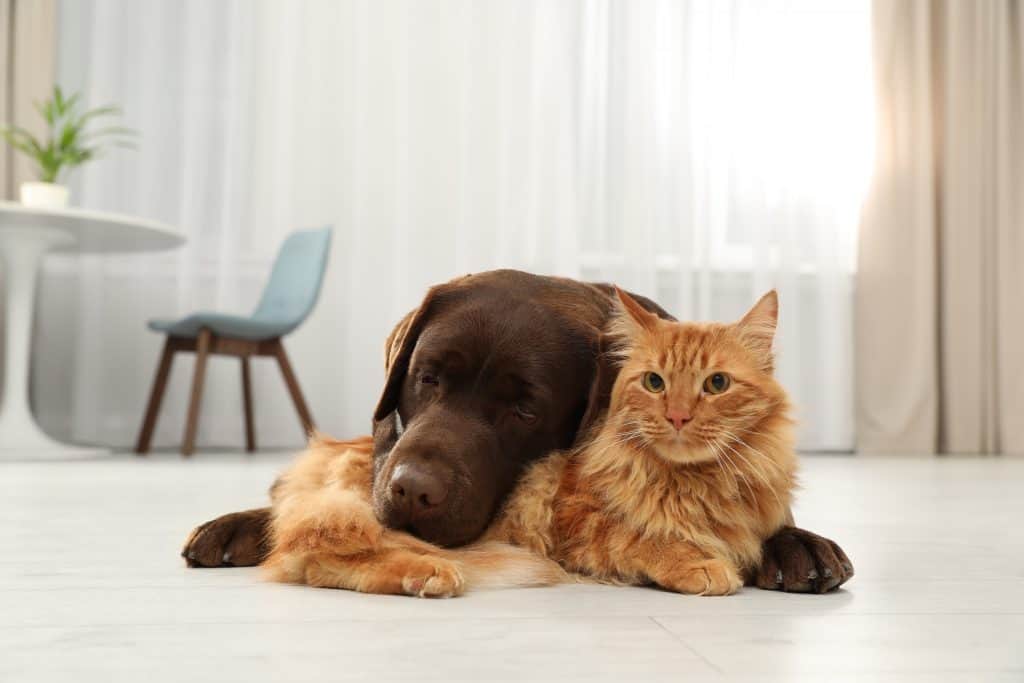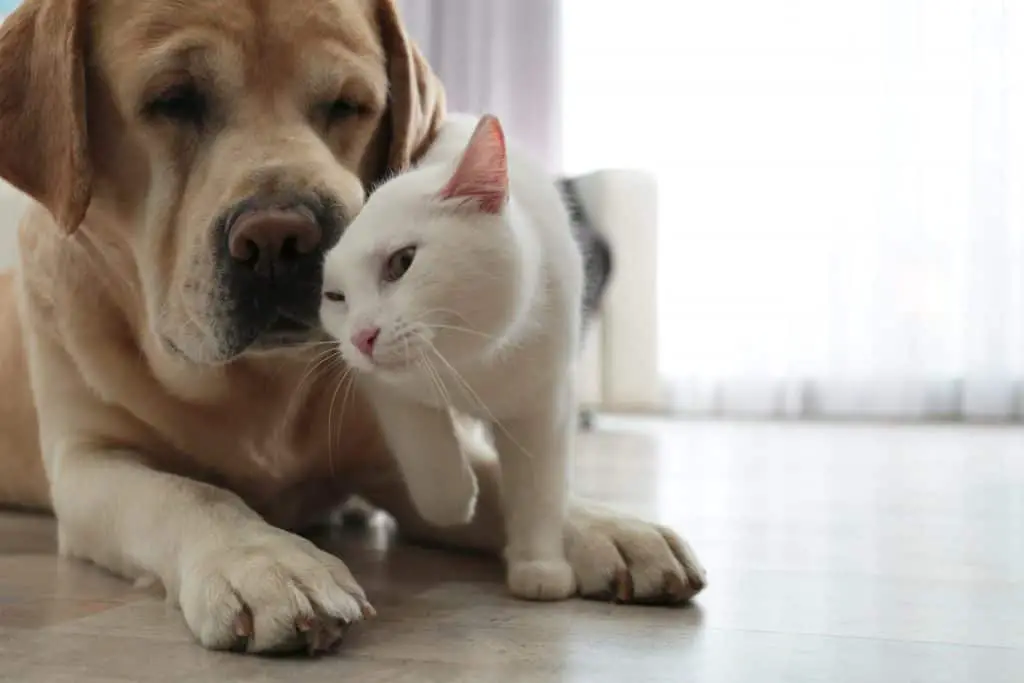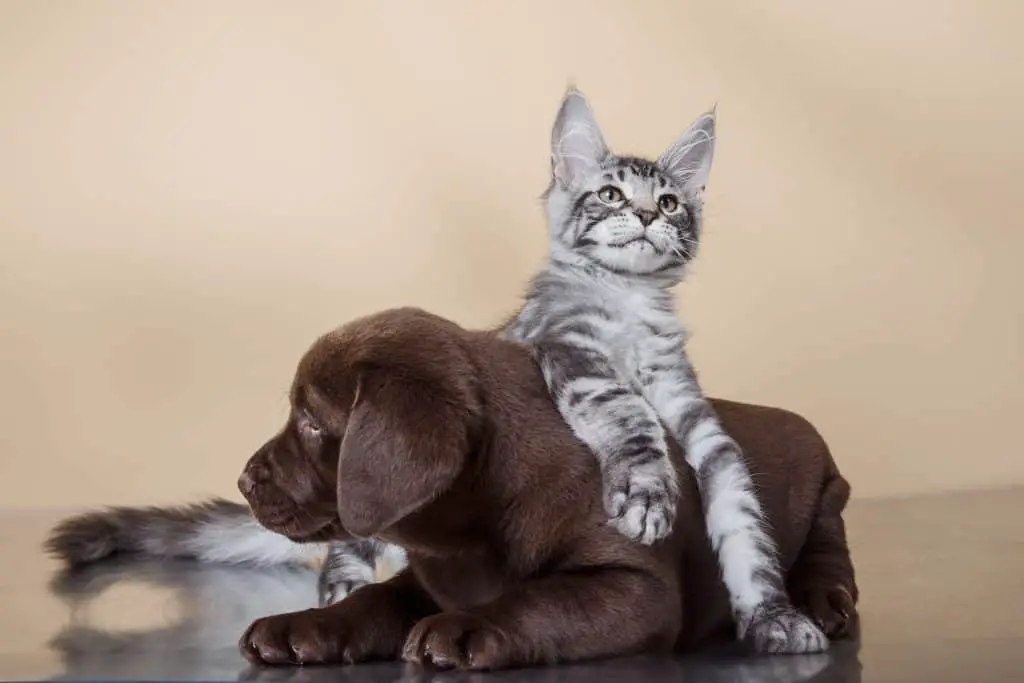
One of the biggest problems Labrador parents will have to face eventually is whether their dog gets along well with other pets. Getting them used to other people and other dogs can be easy, but what about cats? Well, in the United States, about 40% of households have at least one dog, while 33% have at least one cat. It’s not unreasonable to think that there’s plenty of overlap between the two.
Having these two pets coexist in one household should be possible, right? How do people do it? Do they cohabit peacefully all the time? What should you do when they fight? We’ll try to answer these questions here today.

Do Dogs and Cats Hate Each Other?
When cats and dogs fight, you’ll understand why people think these two are mortal enemies. We’ve made them a benchmark for fighting when we coined the saying “fighting like cats and dogs”. But do they hate each other, or is there something else at play?
To better understand why dogs and cats interact the way they do, you’ll have to look into their instincts. Cats tend to be slinky and would prefer to avoid confrontation, whether they’re stalking prey or interacting with bigger animals.
If you’ve been on the internet long enough, you’d have seen videos of rats or smaller animals fighting back a much larger cat and would usually chase the cat away. That’s how much a cat’s instinct tells it to avoid confrontation. So, a cat’s natural reaction when they see a bigger animal, say a Labrador, is to avoid it. This usually means running away.
Now dogs, they’re no different than cats. Most of the time, unless you’ve trained it out of them, they’ll just go by whatever their instincts tell them to. Dogs, even the smaller breeds, retain a very strong hunting instinct. This is why dogs love to chase down moving objects. It doesn’t matter if it’s a ball you threw, a chipmunk running across the yard, or a cat running away from your dog.
So no, dogs don’t hate cats, but the way either of their brains is wired makes them incompatible. Of course, that doesn’t mean that they can’t coexist.

Are Labradors Aggressive Towards Other Animals?
So, are Labradors good with cats, or any other animal? If you understand Labrador retriever temperament, then you should know that they’re typically not an aggressive breed. So unlike Dobermanns or Rottweilers, they don’t make very good guard dogs. But as we’ve already discussed before, the reason why most dogs chase down cats is because of their hunting instinct, not their aggressive nature.
Labradors were originally bred specifically for their drive to hunt. This strong hunting instinct makes their tendency to chase down other animals more likely. But once they’re trained out of this hunting tendency, Labradors aren’t prone to hurting animals just for the sake of it. They are known to be very gentle, after all. This gentle aspect of Labrador Retriever temperament makes them excellent with children and other pets.
Related post: Are labradors good apartment dogs?
How to Introduce a Cat to Your Labrador
If you already have Labrador and would want to bring home a cat, or vice versa, there’s no guarantee that they will get along, no matter how mellow either of them is with other animals. However, there are steps you can take that can help them get along, or at the very least help them coexist peacefully. Here are the steps you need to take to properly introduce a cat to a Labrador.
Step 1: A Calm Dog is a Good Dog
An unexercised Lab is an angsty dog, so before you start the introductions, make sure that your Lab has had its daily exercise beforehand. Bored dogs are more likely to chase whatever it is that catches their attention. It should also be a good idea to feed your dog before the introduction if you haven’t already. If a dog is relaxed and content, it’ll be coming into a new situation with a calmer mindset.
If your Labrador is the new guy, make sure to give them time to adjust to their new home before you introduce them to the resident cat. Keep your cat in a separate room until you feel your dog is ready to meet the rest of the family.
Step 2: Out of Sight, But Not Out of Smell
Make sure that you keep your cat in a secure area before the introduction. The dog should be able to smell the cat already, and the cat should also smell the dog, so they should be aware of each other’s presence at this point. Allowing your dog to smell the cat without them seeing the cat makes them more curious rather than excited.
Having an excitable Lab is a bad idea at this point. Make sure that your Lab is comfortable in its current environment. Allow them to explore the rest of the house. If your dog is the resident animal, and the cat is the new pet, let your dog explore anyway. It might not be the first time they’ve been to your house, but it is their first time to do it with the new cat smells.
After a while, you should reverse the situation. If you’re taking your dog out for a walk, you can have your cat explore the rest of the house, so they can be aware of your dog’s scent. That way, they would’ve already met without making any physical contact.
Step 3: Supervised Play
Next is the first introduction. Keep your Labrador on a leash but allow your cat to roam freely. Labradors are more likely to hurt cats, even if they don’t mean to, given their size. Even a rambunctious enough puppy could do enough harm.
Allow them to act naturally, but make sure to hold your dog back if it starts acting out. If it’s looking at your cat in an alert manner, such as upright back and ears, a small tug from the leash should distract them from whatever it is they’re thinking. The trick here is to encourage an atmosphere of calm and relaxation.
There’s no need to feel disappointed when they don’t end up as friends the first time. Your objective right now is to have them comfortable with each other. Once their first date is done, keep them in separate rooms once more.
Do this as often as possible in the next few days, until you’re confident enough that your Lab wouldn’t lunge at your cat the moment you take off their leash. If either of them can get along, or at the very least, they ignore each other (which is the best-case scenario for many pet owners), you can start letting them roam in the house freely.

What to Do if your Lab and Cat Don’t Get Along
Sometimes, regardless of what you do, your Lab and your cat just wouldn’t get along. Don’t lose hope. Keep trying to maximize their interaction time and keep supervising them. Some pets just take a long time to get used to new things, but eventually, it will happen. The last thing you’d want to do is to keep them separated forever.
Whenever a fight does happen, which can be inevitable sometimes, try not to get in the way of it. You may end up getting hurt yourself. You can use a hose or a water bottle to spray either pet to stop them from fighting, though punishment can make the matter worse. If they do fight often, there’s no shame in asking for help. Get in touch with an animal trainer or behaviorist, and maybe you can still make best friends out of your Lab and cat.
Related post: LABRADOR TEMPERAMENT – ALL YOU NEED TO KNOW


